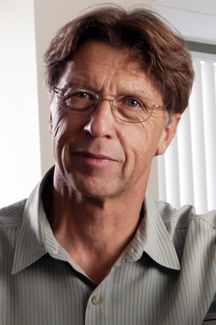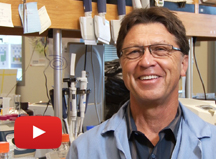Bruce Torbett: Science Knows No Bounds
By Madeline McCurry-Schmidt
Stem cell therapy, cancer treatments and HIV research come together in the lab of Associate Professor Bruce Torbett at The Scripps Research Institute (TSRI). Torbett’s broad interests put him in a unique position to answer a nagging question in cell biology: Why is it so hard to genetically modify stem cells, a task that has promise for replacing diseased cells in the body.
“That’s something that has befuddled the field for many years,” said Torbett. “How can we alter cells safely, effectively, efficiently and cheaply?”
Recent breakthroughs in his lab are bringing gene therapy and new treatments for cancer and HIV closer to reality.
Unlocking Stem Cells
The body depends on hematopoietic stem cells (which all of us have in our bone marrow) to produce immune system cells and replenish the blood supply. Because these stem cells are so crucial, they’ve evolved defenses to keep out invading pathogens.
If you’re a stem cell, that’s a good thing. If you’re Bruce Torbett, that’s an irresistible challenge.
Genetic mutations in hematopoietic stem cells cause diseases such as leukemia and sickle cell anemia. Torbett knows that if he can alter those disease-causing genes, he can turn stem cells into healthy cell-producing machines.
Torbett has been a pioneer in efforts to use altered versions of HIV, called lentivirus vectors, to break through stem cell defenses. “We modified HIV and changed it so it was safe and not infectious, and used that to deliver our genetic material into human stem cells,” said Torbett.
To get these lentivirus vectors into the body, the scientists tried extracting stem cells, inserting beneficial genetic material and then returning the modified cells to the body.
Early experiments were disappointing, though, with only 20 to 30 percent of the stem cells expressing the beneficial genes—not enough for the treatment to help patients. To fix this problem, Torbett and his lab members continued to study the process of gene delivery and looked for new ways to target cells.
Then in 2014, Torbett and TSRI graduate student Cathy Wang found that an already approved cancer drug can unlock stem cells and allow beneficial genes into 80 percent of cells.
“I’m extremely proud of that,” said Torbett. “It took 14 years, but I’m glad I got to see the process from beginning to end.”
Wang, who was first author of the new study, said she learned a lot from Torbett and admired his persistence. “Good research involves a lot of hard work and failed attempts, and it is important to keep an even keel,” Wang said.
Understanding Cancer
This breakthrough in gene delivery means Torbett is closer to designing new therapies for many types of cancer. He hopes gene therapy will be a safer alternative to chemotherapy. “Instead of using a sledgehammer to control cancer, you can use a very fine-honed approach,” he said.
Helping cancer patients is a personal mission for Torbett. He grew up with a passion for medicine—competing in science fairs and collecting coins for The March of Dimes.
In the mid-1990s, Torbett described the role of a gene transcription factor called PU.1. People without PU.1 cannot make the myeloid cells (derived from hematopoietic stem cells) that defend the body against infections. These people have dangerous recurring bacterial and viral infections.
Torbett found that without functional PU.1, some cells that should become healthy myeloid cells instead undergo molecular changes that may promote cancer. A study he conducted with former lab member Mario Tschan showed that PU.1 also binds with a tumor suppressor that inhibits the body’s ability to limit cancer growth and kill abnormal cells.
“My collaboration with Bruce has resulted in 20 peer-reviewed publications so far,” said Tschan, now a research group leader at the University of Bern, Switzerland, who has gone on to investigate the role of PU.1 in acute myeloid leukemia. “I learned a lot from his extremely broad scientific knowledge and expertise in immunology, particularly myeloid biology, lentiviral vector technology and HIV.”
Torbett thinks the environment at TSRI makes this kind of cross-disciplinary research possible. “Scripps is an amazing place. If you don’t have the expertise in your group, you can walk next door and find someone to help you,” said Torbett. “We go from biochemistry to structural biology to physiology. The science here knows no bounds.”
Boosting the Immune System
Torbett also sees gene therapy as a potential way to help HIV patients.
New drugs have turned HIV from an acute, fast-killing disease in 1980s to a chronic, often manageable disease today. This shift means many people are experiencing the side effects—such as cardiovascular problems and premature aging—of taking HIV drugs long term. Gene therapy could be a healthier alternative.
“Wouldn’t it be nice to be able to genetically modify the body such that it is resilient and resistant to HIV?” he said.
HIV attacks the immune cells that normally defend the body from viruses, fungi and bacteria. Torbett wants to give back the body its immune system. “We want to be able to take out the very cells that are attacked and genetically modify them so they are no longer affected by HIV,” said Torbett.
Torbett is also studying whether gene therapy could be used to modify the virus itself and perhaps even stop drug resistance.
“We’ve studied how HIV becomes resistant to certain drugs that target something called protease, which is an enzyme needed by HIV,” said Torbett. “Our work has led to insights into how drug resistance occurs.”
Could HIV be manipulated through gene therapy to be less of a threat? Torbett is looking into it.
Torbett sees limitless possibilities for gene therapy. In just the past year, Torbett began working with researchers at the University of California, San Diego to find ways to regulate the hematopoietic stem cell system and produce cells that better fight infection and heal wounds.
Understanding stem cells has taken Torbett decades, but he now believes this kind of gene therapy is ready for the clinic. A born-and-bred San Diegan and Chargers fan, Torbett can’t help making a football analogy: “These experiments are like a training program to bring discoveries to the clinic,” said Torbett.
To learn more, see Torbett's faculty biosketch and the Torbett lab website.
Send comments to: press[at]scripps.edu















